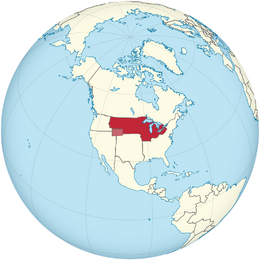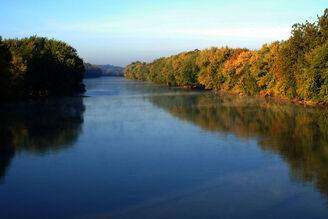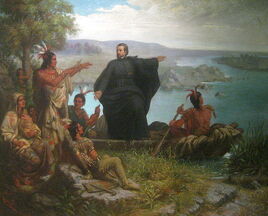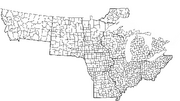- This country is a part of Altverse.
| |||||
|
Anthem: Chimes of Indiana | |||||
 | |||||
| Capital and largest city |
Chicago | ||||
| Official languages |
Hoosier English French | ||||
| Demonym | Hoosier | ||||
| Government | Federal democratic constitutional republic | ||||
| From Albion-Gaul | |||||
• Wabash Oath |
August 1st, 1776 | ||||
| June 8th, 2015 | |||||
| Area | |||||
• Total |
1,312,525 km2 (506,769 sq mi) (12) | ||||
| Population | |||||
• 2014 estimate |
66,892,722 | ||||
• 2010 census |
63,599,811 | ||||
| GDP (PPP) | 2014 estimate | ||||
• Total |
$4.655 trillion (5th) | ||||
• Per capita |
$31,555 (22nd) | ||||
| GDP (nominal) | 2014 estimate | ||||
• Total |
$4.655 trillion (5th) | ||||
• Per capita |
48,001 (8th) | ||||
| Gini (2014) |
0.56 low | ||||
| HDI |
0.674 medium · medium | ||||
| Currency | Wabash Dollar ($) (WSD) | ||||
| Time zone | -6 | ||||
| WST | |||||
| Drives on the | right | ||||
| Calling code | +502 | ||||
| Internet TLD | .W | ||||
Etymology[]

The Wabash River is located in the Department of Indiana, and the Department of Ohio. It is the basis of much of Indiana's romanticism and culture; an example being the On the Banks of the Wabash, Far Away, the nations anthem.
The word Wabash is derived from the Miami word meaning “shining white” or “water over white stones.” (Waapaahšiki Siipiiwi) [1] Most preferred the idea of 'Indiana' which in turn was Latin for "land of the Indians"- but many concerned with the notion, at the Duval Confederate Convention, claimed there wasn't enough Indians in the territory anymore to be claimed as 'Land of the Indians'. Where the convention was being held also sat on the banks of the Wabash River, which had gained a sacred connotation to the Christian population, it was the only river to be used for baptism. The three founding leaders and the settlers at the convention agreed on the name of the 'Wabash Confederation'.
In the description of the Founding of a Nation by Jérémie Dubost the scene was preformed in this manner;
Three men descended into the river,
to be received by Christ himself.
Aye, we indeed remember and miss thee Zion,
But none shall weep on this day.
Aye, Let the words of my mouth,
and the meditation of my heart,
be acceptable in thy sight.Cahun, Malford
and Glaisyer raised their hands,
basked in the Wabash and proclaimed -
"From Providence's grace,
We do declare a nation for the people,
where we may be free.
To never be afraid of human power,
We shall only fear God's judgement.
For Wabash, her Banks and her rolling waters!
Rather than live as slaves,
We shall die free!
— Jérémie Dubost, Founding of a Nation, August 1st, 1776
History[]
Early History[]

Monks Mound, roughly the same size at its base as the Great Pyramid of Giza
Several tribes laid claim to the area now occupied by the Wabash Confederation; primarily groups from the Algonquian language family; the Miami, Ho-Chunk, Potawatomi and the people of the Neutral Nation. Since their early settlement to the the 16th century the natives were crafted in the arts of hunting with bows, knives made out of bones. Most of them lived in oval or conical wigwams that could be easily moved away. Various tribes had different ways of living. The Ojibwas were primarily hunters and fishing was also important in the Ojibwas economy. Other tribes such as Sac, Fox, and Miami, both hunted and farmed.
Wabash tribes were known as 'Moundbuilders' and built extensively large mounds in the departments of Indiana, Michigan, Wisconsin, Ohio and Minnesota. Created as ceremonial centers for ritual and holding the dead. Most were built nearly 2,200 to 1,600 years ago- when the Indians of the Midwest had left their nomadic life and settled to begin in the practice of agriculture. Most of the conical mounds at these centers were built over wood structures that served as temples for prayer in general or over crypts. Valuable objects imported from great distances were left as offerings to accompany the prayers. Groups of pilgrims representing kin groups or religious societies buried deceased men and women leaders with collections of offerings and in this way asserted their collective identity. [2]
Located in south western portion of the Indiana Department, the ancient city of Cahokia was built in 1050 A.D. Recorded as the largest and most influential settlement of the Mississipian culture its large labor force and abundance of corn made it possible for the city to focus on building public monuments. Cahokia is home to the largest prehistoric earthen construction in the Americas north of Mexico, Monks Mound.
French exploration[]

Marquette was essential in the evangelism of the gospel and the establishment of Roman Catholicism in the Wabash Confederation
European exploration of the region began with Jacques Cartier's discovery of Quebec and the Saint Lawrence River in 1534. Prescribed by King King Francis to set sail on April 20th, 1534 sailed across the Atlantic Ocean in hopes of finding the highly desirable Northwest Passage; which would open markets to the spice rich continent of Asia. Cartier took twenty days to travel the ocean and on May 10th set eyes upon Newfoundland. Sailing north of the island, him and his crew maneuvered through the Strait of Belle Isle and into the Gulf of Saint Lawrence. On July 24th, Cartier approached aboriginals on the northern beaches of Gaspé Bay, exchanging gifts and leaving them a 10 meter cross bearing the words "Long Live the King of France".
With French developments in Quebec and the founding of New France, the French division of the Society of Jesus deployed Jacques Marquette as a missionary into the Great Lakes region. In 1668, Marquette founded the first Roman Catholic mission in Wabash in Sault Ste. Marie, in the northern Department of Wisconsin. Further exploration of the lakes lead him to discover present day Chicago. René-Robert Cavelier, Sieur de La Salle, of Rouen ventured to the new world in March 27, 1667 with the Jesuits, but upon his arrival was dismissed due to "moral weakness" (he would later become hostile to the idea of the Jesuit organization), and proceeded to explore on his own account. In 1679 claimed the St. Joseph and Kankake rivers for the King in France and was essential in the first stages of colonization.
Settlement of French & English[]
English Americans and French fur traders began to settle sparsely through the territory in the late 1680's and the early 1700's. Population growth was explosive primarily in the Departments of Indiana, Ohio and Michigan. French populations dotted along the Mississippi River and the Wabash River, while the primarily English speaking population occupied the Ohio River Basin. Several of the Wabash's largest cities were founded during this period, including Detroit, Chicago and St. Louis. Albion-Gaul the explosive colonization dangerous in terms of trying to quell Indian hostility; when several settlements in Michigan and Ohio were being evicted and being forced to move to Canada and the Thirteen Colonies the French and English colonists banded together in the Northwestern Insurgency.
Demographics[]
Population[]
| Racial composition | 1990 | 2005 | 2015 |
|---|---|---|---|
| White | 90.7% | 86.8% | 76.5% |
| Black | 4.1% | 5.4% | 7.8% |
| Native | 2.3% | 3.4% | 4.6% |
| Other race | 2.2% | 1% | 1.3% |
| Two or more races | 2.1% | 3.4% | 9.8% |
Conducted every five years, the Wabash General Census produces statistics for cities, departments and records the populations religious, racial and lingual affiliation. On May 6th, 2015, the census recorded 68,897,900 people were living within the Wabash, which supported the notion that the nation is experiencing a population boom. Under the 24th government, the population stagnated with the states overreaching authority in controlling the population. Marianne Beaumont's secular government also promoted birth control, and legalized abortion in 2010, which slightly counterbalanced the growth the nation was experiencing. In global standings, the Wabash is 23rd in population, ahead of the Democratic Republic of the Congo and Gaul.
Statistics on the total fertility rate, show that the Wabash leads in North America, showing that Hooisers on average have 4-5 children, which has risen from 2010's statistic fertility rate of 3.7. During the 50's and 60's, the rates were at their highest with the rate peaking at 5.4. White Hoosiers typically have the most children; 78% of whom are convinced in wedlock. Hoosiers of African descent, have on average 3-2 children, and nearly 67% of those children are convinced in wedlock; drastically higher than African-Sierrans and African-Americans. Aboriginal Hoosiers, hold similar statistics to African Hoosiers in accordance to fertility rates, but most children are born out of wedlock, with only 34% of Native Hoosiers having children whiled married.
Wabash's population growth is primarily from its own growth and experiences some of the lowest amounts of immigration in the North America. With only 4% of Hoosiers being immigrants from nations in the proper of North America. Only 2% claim they are former citizens from other nations. Mostly due to its landlocked status, the principle that previous governments were not friendly to foreigners has discouraged many from immigrating to the Republic.
Religion[]
| Affiliation | % of the Hoosier population | |
|---|---|---|
| Christian | 87 | |
| Protestant | 68 | |
| Catholic | 16 | |
| Eastern Orthodox | 1 | |
| Other Christian | 2 | |
| Canaanism | 7 | |
| Unaffiliated | 8 | |
| Total | 100 | |
Language[]
Economy[]

Gary Works, located in Gary, Indiana is the largest steel mill in the world. It employs nearly 30,000 people.
Wabash has a fairly liberal market economy, in which investment, production and distribution by companies is solely guided on the basis of supply and demand. Government regulation is only partially found in the farming and banking sectors; finding the latter (owned primarily by outside corporations) as distasteful. While Wabash is considered as developed country, economic inequality is quite rampant due to early tensions between the East and West. Involved heavily in international trade, the nation is a massive producer of steel, cars, pharmaceuticals and nuclear technology. The Wabash Confederation is the 13th largest importer and the 9th largest exporter. Since the 2010 coup, corporations have flourished under the generous tax breaks by the government, farmers have increased crop yield and innovation has been promoted.
Known as the breadbasket of North America, nearly all of the continent's corn, soy, barley and wheat is grown here. The nations corn belt is the highest producer of corn in the world, providing feed for animals in neighboring countries and meat producers domestically. Food processing is entangled with the large agricultural sector which has fostered several pop brands.
Chicago, Detroit and Indianapolis are Wabash's primary centers for industry and during the 2008 Great Recession was most heavily impacted. Nearly 3.4 million jobs were lost between 2008 and 2010, and generated a unemployment problem. Since 2010, the government has pressured new schemes which included corporations to employ the population and bring back a technological backbone. Home to Fordism, manufacturing has been the backbone of the nation since the industrial revolution.
Nuclear industry[]
Nuclear power is the Wabash's primary source of electricity, generating nearly 62% of its energy. Wabash is the largest producer of nuclear energy and currently exports nearly 43% of the plants energy to neighboring states. Wabash sought the idea of nuclear power, but rather than the usage as weapons it wanted to provide power. President George Matthews pushed for the creation of the Department for Nuclear Exploration in 1931 and began recruiting some of Wabash's most prominent physicists. With association with the University of Chicago created the first artificial nuclear reactor; the Chicago Pile-1. On December 2nd, 1942 2 the first ever nuclear reaction occurred, leading the Sierrans and Americans to proceed with the Manhattan Project.
First commercially pushed by William Bradford in 1959 under subsidization of the 23rd government. High demand for energy skyrocketed as energy consumption crunched the current coal dependent energy market. In 1958, the Great Lakes Blackouts were an off and on systematic consumption control through forced power outages. Balford and his company completed their first plant on the banks of the Ohio River around Madison, Indiana. Bradford subsidized in his his efforts by the government developed the now largest nuclear plant operator in the Wabash, Balford Energy. The largest plant owned by the Balford Energy Corporation is the Superior-Michigan Nuclear Power Plant, built in 2011, it generates nearly 9,500 megawatts.
Agriculture[]
Politics and government[]
Law[]
Departments[]

Political parties[]
Foreign relations[]
Culture[]
See Also: Hoosier Culture
Divided primarily among its French and English lineage, the identity has been shaped by several decades of immigration, downturn and cultural and literary revolutions. Considered Western, the root for its values and traditions are primarily from its root of an agrarian and religious background. Its powerful Protestant majority in its northern Departments were fostered by the large wave of Scandinavian people during the 1910's and 1920's. Presence of an African majority in the southern half of the Ohio Department is evident, most of whom settled in the region during the American Civil War, with them brought their culture, food and music. Cities such as Chicago, Saint Louis, Detroit and Cleveland have large Hoosiers with African ancestral ties. Perhaps the most powerful movement, which still holds strong to current day would be the naturalist movement; the depiction of everyday life being beautiful. Simple living and the appreciation of nature spawned in the early 1900's, but was suppressed under the 22nd, 23rd and 24th governments who saw the movement as weak and detrimental to a nation embroiled in the World Wars. During the more conservative eras of the Confederation, romanticism was by far more appraised.
Known as Hoosier kindness, the humble manner in which Hoosier's present themselves to others is regarded courteous, reserved, and mild-mannered. While reserved to keep from causing a confrontation, foreigners or a trouble maker can be quickly confronted if angered. Public displays of emotion, crying, arguments in are an extremely rare sight. This is from the nations undying creed of Self-denial and collectivism. Conversation in public places is the norm, even with strangers. Regarded as one of the most extroverted nations in the world, most outsiders find the hospitality outlandish and quite passive aggressive. Wabash sociologist Alfred Gylf, notes that the Hoosier modesty comes from the decades of respect for authority, keeping the social structure and keeping people in their place.
Ethnicity, tied to the old world was strong up until the Civil War. French still considered themselves French, English considered themselves English- the idea of a nationality of the Wabash was null. It wasn't until 1833 did John Finley release the poem "The Hoosier's Nest" that created the identity of a nation;
Blest Indiana! in thy soil
Are found the sure rewards of toil, Where honest poverty and worth May make a Paradise on earth.
— John Finley, The Hoosier's Nest, 1833
Sexual morality[]
Sexual modesty is still strong within the country, female students at public schools are still issued long skirts and long sleeved shirts. Couples preforming Public display of affection is highly shunned, while hugging between friends of the same sex is highly acceptable. Pornography be has prohibited since the dawn the Internet, and was even regarded as a felony in the older past governments but since the institution of Beaumont its decriminalization has occurred. Prostitution is forbidden and any participating with or practicing the profession can be jailed, fined or registered as a sex offender.
Literature and philosophy[]
Architecture and art[]
Music[]
Cuisine[]
Drawing from European cuisine from nations such as Westland, Kalmar Union, the Commonwealth of Britannia, France and Germany, Hoosier cuisine is distinctive in that it draws from many origins and creates a new item. In Chicago, several dishes are signature to the city itself; the most popular being the Chicago-style hot dog and the Chicago deep dish style pizza. Popular in Indianapolis, and New Albany the local pizza style is distinctive due to its thin and flat shape and is popular among Hoosiers in the eastern half of the nation. The Pork tenderloin sandwich and the Buffalo burger are the most widely recognized sandwiches of the nation. With the Hoosier Bison being a symbol of the nation, treatment and production of Bison meat is some of the most regulated; requiring the buffalo's be given quality feed and plenty of roaming area. Germans whom settled in the northern departments; and predominately around the cities of Milwaukee brought with them sauerkraut and the bratwurmst. In western Iowa the Reuben sandwich is hailed as a local delicacy and is a particularly favorite dish among Hoosiers nationwide.
In the African-Hooiser community; many developed their own cuisine from their American counterparts. In Chicago, the traditional African dish of Yassa, has grown to be redeveloped in several ways that have accommodated the environment of the Wabash. In Chicago, the dish is assorted with Salmon and Bison beef, and is generally sprinkled over with corn and onion. In Southern Ohio, the dish is converted to using fried fish from the Ohio River, and applying pork tenderloin to the dish with brown rice. Sauces deriving from Soybean are the most typical of dressing for African-Hoosier dishes.
In Southern Indiana, the region is a clash of Southern cuisine and a regional variation from the whole nation. Hit the hardest from the Great Depression in the 1930's, several dishes had become dominant for the poorer community. Known infamously around the world, the Hoosier onion sandwich, also known as Bread and onion the dish was originally complemented with government cheese and mayonnaise and onion. In regards to the onion, several variations can be applied to the dish and can greatly effect the taste. In New Albany, were the dish originated; the yellow onion was predominately used. In recent decades, when the white onion is in season, most across the nation prefer the sweeter onion over the rich sulfur packed yellow counterpart. Many call the cities along the Ohio River the "crying south" due to the areas association of onions; but humorous tradition holds that southern Hoosiers no longer have the lacrimal gland.
Sports[]
References[]
See also[]
| ||||||||||||||||||||||||||||||||||||||


